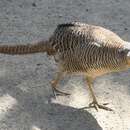Biology
provided by Arkive
Reeves's pheasant aggregates into flocks of ten or more in autumn and winter, reducing to four to eight in spring, and breaking up in March with the onset of the breeding season, when males start to establish territories (6) (7). Males advertise their territories and attract females by calling and 'wing-whirring' from March to early June. This pheasant is thought to be primarily monogamous, but occasionally polygamous (6). Females lay six to ten eggs into a nest on the ground, usually under bushes or in grass (2) (6). Incubation lasts 24 to 25 days and is performed by the female alone (6).
This omnivorous bird forages by scratching and digging in the ground, mainly for fruits and seeds, but also for buds, fresh leaves, flowers and some insects, snails and earthworms (2) (6). Cultivated beans, cereals and root crops are also taken from nearby farmland (6).
Conservation
provided by Arkive
Reeves's pheasant is a Nationally Protected Species (Second Class) in China, and listed as a protected species by the provincial governments of some of the provinces where it occurs. In the mid-1990s, a new national law was declared in China, forbidding the keeping of guns in private homes, including shotguns used for hunting, which has led to a significant reduction in hunting with guns of Chinese wildlife. Nevertheless, other forms of hunting are still widespread, including the use of poison baits and nets. Reeves's pheasant has a relatively wide distribution, and occurs in many protected areas, including Tuoda forest in Guizhou, established as a nature reserve by the local government in 1992 specifically for the conservation of Reeves's pheasant and its habitat, although illegal felling has since occurred here. Much work has been done around the reserve to raise local awareness of the plight of this species, and conservation programmes have been developed. Around 3,000 specimens are estimated to exist in captivity around the world, and Dongzhai Nature Reserve and Henan Normal University have established a captive-breeding centre. However, where the cause of the decline is habitat loss, bolstering wild populations with captive stock would likely have a limited impact on the long-term conservation of this rare, long-tailed pheasant (6).
Description
provided by Arkive
This boldly patterned pheasant (3) is instantly recognisable, having some of the longest tail feathers of any bird species (4). The male has bright golden-chestnut upper parts, with black borders to each feather creating a strongly scaled appearance, while the upper breast is darker chestnut to black, and the lower breast and side feathers are white, tipped in black (3) (5). The male's tremendously long orange-buff tail is conspicuously barred with black and white, and the head and neck are white, encircled with a distinctive black mask across the eyes and a black collar around the neck (3). The female has a shorter tail than the male, and as in most pheasants, is more dull-coloured, being mottled brown, buff and white, providing excellent camouflage when nesting (5). The face and throat are buff, with a brown crown and band behind the eye, and the tail is barred with buff and brown (3) (5).
Habitat
provided by Arkive
Found in a variety of forest types, mainly broadleaf forests dominated by oaks, usually with a dense canopy and sparse undergrowth, but also in conifer forest, scrub, and farmland next to the forest edge (3), between 200 and 2,600 metres above sea level (2).
Range
provided by Arkive
Reeves's pheasant occupies a fragmented distribution across the mountainous areas of central and east China, and has also been introduced to Hawaii and various parts of Europe (3).
Status
provided by Arkive
Classified as Vulnerable (VU) on the IUCN Red List 2007 (1).
Threats
provided by Arkive
Reeves's pheasant populations are severely fragmented and declining in the face of ongoing habitat loss and over-hunting (3). Widespread deforestation as a result of logging operations, fuelwood collecting and the demand for agricultural land is the primary threat to this magnificent bird. Hunting is thought to pose an additional threat, and its eggs are also collected for food. In some areas, this pheasant is killed because it is regarded as an agricultural pest, and some are poisoned on farmland by bait intended for rodents. In the past, it was hunted for its long tail feathers, which were used as decoration in Peking opera costumes, but plastic feathers are now increasingly being used (6).

